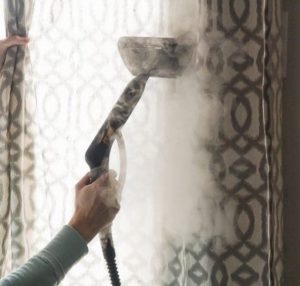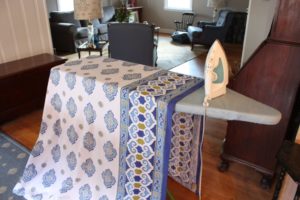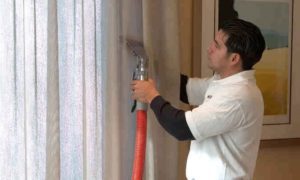 At first glance, ironing curtains is a simple and quick process. However, in practice, when trying to iron them, you may encounter some difficulties.
At first glance, ironing curtains is a simple and quick process. However, in practice, when trying to iron them, you may encounter some difficulties.
To avoid mistakes and quickly tidy up your curtains, you just need to know a few simple tricks.
Step-by-step instruction
- It is better to start ironing with a slightly damp fabric - this will make it easier to remove wrinkles, especially on heavy materials. If the fabrics have already dried, use the steaming mode to remove folds and creases.
- Organza and other delicate materials should be ironed through an additional cotton pad placed under the curtain.
Important! For lining, be sure to use white cotton fabric - colored materials may fade under the influence of temperature.
- The ironing temperature is selected strictly in accordance with the temperature conditions specified for this type of fabric.
- To iron seams, use a liner of one or two layers of gauze.While ironing seams and stitching areas, turn off the steam function on the iron - the steam may not damage dense fabric, but delicate materials will go into “waves” under the influence of steam.
 The sizes of modern ironing boards are not designed for large and long items. To prevent the fabric from falling to the floor during ironing:
The sizes of modern ironing boards are not designed for large and long items. To prevent the fabric from falling to the floor during ironing:
- Place the ironing board as close to the window as possible. Start the process from the top of the curtain, gradually lowering it down. When the fabric begins to touch the floor, hang the curtain on the curtain rod - this way you can iron its lower part without any problems.
- You can use any round object 1-1.5 meters high. Start ironing from the bottom of the curtain, gradually wrapping the ironed fabric on a stick - this way the fabric will not wrinkle or get dirty.
The better to iron
The most common technique for ironing curtains is regular iron. An iron with a steam function will be optimal - it will help deal with wrinkles on heavy materials.
You can also use hand or floor steamers - they do an excellent job of straightening by weight.
How quickly can you iron curtains?
- Let the fabrics dry after washing. Start ironing when the fabric is slightly damp.
- Lay out your ironing board and prepare damp gauze and padding for delicate materials.
- Select the temperature setting according to the type of product.
How to iron curtains without an iron
 You can iron curtains without an iron using a steam generator or steamer. Directed steam exposure will help smooth the fabric without using a regular iron. Also, using steamers will eliminate the need to use a bulky ironing board.
You can iron curtains without an iron using a steam generator or steamer. Directed steam exposure will help smooth the fabric without using a regular iron. Also, using steamers will eliminate the need to use a bulky ironing board.
Important! You need to start steaming from top to bottom, slightly pulling the fabric with your hand.
How to straighten curtains by weight
Large curtains are not always convenient to iron on a board. For ironing by weight, a hand-held or floor-mounted steamer is suitable.
- Using a hand steamer, it is easy to iron straight or classic curtains. The only drawback of a hand-held steamer is the need to use an extension cord when working with long items.
- The floor steamer is ideal for models with a lot of folds. High power will quickly smooth the product without damaging the material, and the ability to heat up the steam iron will prevent excess water from settling on the fabric.
How to iron organza curtains
 Organza and chiffon do not like moisture and steaming, and do not react well to high temperatures. Therefore, when working with organza or chiffon, use the minimum temperature setting, otherwise your curtains may become “wavey.”
Organza and chiffon do not like moisture and steaming, and do not react well to high temperatures. Therefore, when working with organza or chiffon, use the minimum temperature setting, otherwise your curtains may become “wavey.”
Common mistakes when ironing
- Incorrect temperature selection. To avoid this, carefully study the labels on the products - as a rule, the optimal temperature for a given type of fabric is indicated there.
- Trying to steam delicate fabrics. Silk, organza, taffeta or velvet - these materials are easily deformed under the influence of steam.
- Ironing without backing. In this case, there is a risk of getting unsightly marks on the front side of the curtain.
- Also common mistakes include ironing embroidery or rhinestones on the curtains on the front side. At best, such “decorations” will simply become deformed, and at worst, they will “stick” to the soleplate of the iron, ruining both the iron and the curtains.
Additional tips for ironing curtains
 Silk and taffeta. Ironing of these fabrics is carried out only from the inside when setting the minimum temperature. Be sure to iron silk and taffeta dry, without wetting them with water.
Silk and taffeta. Ironing of these fabrics is carried out only from the inside when setting the minimum temperature. Be sure to iron silk and taffeta dry, without wetting them with water.- Curtains with embroidery. Ironing is carried out from the wrong side of the product; the fabric must first be slightly moistened with water.
- Velvet. This is a very capricious material, so it must be ironed dry and only from the wrong side. Do not use the steam mode for velvet - under the influence of steam, such fabric may become deformed.
- Curtains with lining. This type of curtain needs to be ironed on both sides - on the front and back sides. The temperature regime must be selected for each side separately.
Conclusion
All of the above tricks will help you quickly iron your curtains while maintaining their aesthetic appearance. The main thing is to carefully select the temperature regime and use fabric linings under the front side of the curtain.



 0
0





